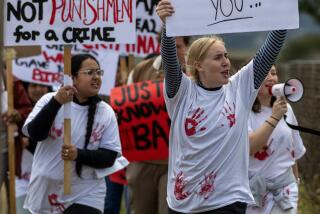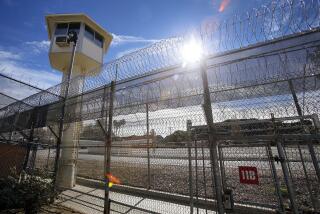Shooting Death of Inmate at Issue
FRESNO â In the days after a guard shot and killed an inmate at Pleasant Valley State Prison last week, corrections staff said a âmajor riotâ involving 300 prisoners had led to the shooting. The use of deadly force, they said, stopped one particularly savage brawl that threatened the life of an inmate.
But prison videotapes and eyewitness accounts detail a far smaller incident involving about 50 inmates in the recreation yard where the deadly shot rang out, according to Fresno County sheriffâs investigators. No inmate in the yard carried a weapon or caused serious injury to another inmate, corrections officials now acknowledge.
The inmate whose life was said to have been in danger walked away from the fight with bruises on his face, corrections officials said. Likewise, no guard faced imminent peril.
Two teams of investigators -- one from the sheriffâs office and one from the state Department of Corrections -- are now probing the Oct. 12 incident, only the second fatal shooting at a California prison since deadly force guidelines were tightened in 1999.
Corrections officials say it is too early to determine whether the shooting was justified. But in past probes, they acknowledge, the absence of weapons and âimminent great bodily harmâ have led investigators to rule such shootings unjustified, costing the state millions of dollars in victim settlements.
âEach shooting is fully investigated not just by a corrections team, but by outside law enforcement,â said Margot Bach, a state corrections spokeswoman. âThereâs a lot more work to do before determining whether this shooting is justified or not.â
The Fresno County coronerâs office said Alejandro Enriquez, a 28-year-old Los Angeles man serving a 15-years-to-life sentence for second-degree murder, was killed by a single gunshot wound to the chest. Prison staff say he was the aggressor in one of several fistfights that erupted in the Facility B yard at the prison in the rural town of Coalinga.
They say Enriquez refused to heed repeated warnings to stop brawling and continued pummeling another inmate even after guards fired five rounds of nonlethal wood blocks.
âIt appears that [Enriquez] was the aggressor and was beating a defenseless inmate,â said Lt. Paul Sanchez, the prisonâs spokesman. âOne officer fired a warning shot and the second officer fired for effect. I imagine they perceived it to be a life-threatening situation.â
But one corrections administrator, who asked not to be named for fear of job retaliation, said the fact that the victim in the fight was not badly injured raises serious questions about the shooting. âOur shooting policy is pretty clear. You donât fire a deadly round to stop a fight unless youâre darn sure an inmate is about to be killed.â
The shooting took place near the same dining hall where inmate Octavio Orozco, 23, was shot and killed by a correctional officer in 1998. In the weeks after that shooting, a high-ranking female administrator went public with charges that Orozcoâs death had resulted from a grave miscalculation by a careless guard. The fight posed no serious harm to inmates or staff, she argued, and could have been stopped any number of ways short of a gunshot.
Orozco, who was serving a nine-year sentence for drug dealing, was one of 39 inmates to die statewide during the 1990s as a result of Californiaâs controversial practice of shooting at prisoners engaged in fistfights and melees. After a yearlong probe by The Times that ended with the stateâs reversing its stance and declaring many of the shootings unjustified, the policy on using deadly force was changed.
The new policy makes firing live rounds from a Mini 14 semiautomatic rifle a last resort. A shot to kill is warranted only to prevent an inmate from escaping or causing catastrophic injuries to staff or another inmate.
The Orozco family later filed a wrongful death lawsuit that was settled in February for $600,000.
The Facility B unit at Pleasant Valley houses about 1,200 inmates -- more than double its capacity. To ease overcrowding, some inmates are housed in the gym. During the evening meal on Oct. 12, guards were releasing inmates from one building when a fight broke out between two prisoners from rival Mexican groups.
Officers stopped the fight and placed the two inmates back in their cells, according to an official account. After both inmates assured guards that no bad blood existed between the groups, the releases of prisoners for the evening meal continued. A few minutes later, however, two more inmates from the same groups began fighting in the yard, which is the size of 1 1/2 football fields, according to prison staff. That fight touched off a melee involving 50 other inmates in the same yard.
âAll the Southern Hispanics began to run from everywhere to the fight,â Sanchez said. âInmates in the gym and the dining hall could see the yard fight and then they began fighting too. This was a classic example of how a single incident can escalate into a major riot involving 300 inmates.â
But Fresno County sheriffâs investigators say videotapes and witness accounts portray not one major riot involving 300 inmates, but three separate fights in three distinct parts of Facility B. As about 50 inmates got involved in fighting or threatening to fight in the yard, other disturbances involving 250 inmates broke out in the gym and dining hall, they say.
Guards were able to bring peace to the gym and dining hall by using pepper spray and shouting verbal warnings to âget down.â But the fight in the yard persisted until two guards, one standing in a gun post tower and the other in the second-floor control booth, fired two live rounds in the yard.
âThe fight in the yard starts out with 30 or 40 inmates and then others run over to join in,â said Sgt. Bob Moore, who heads the sheriffâs team.
âThere is major pummeling going on by more than one person, and officers form a skirmish line. Because the video pans back and forth, you lose a lot of whatâs going on.
âAt some point, the majority of the yard goes down, but a pocket of inmates are still fighting,â Moore continued. âThatâs when two live rounds are fired, one as a warning and the other striking an inmate in the chest.â
Sanchez, the prison spokesman, defended the actions of the two guards who fired the shots. He said they followed the departmentâs policy of escalating force: verbal warnings, pepper spray, firing nonlethal wood block rounds, firing a live warning shot and then finally firing a round âfor effect.â
âItâs a very difficult decision,â he said. âYou have only a second or two to make it. This one inmate was defenseless. If they donât react and he takes a kick in the head, he can die.â
But Bach, the corrections spokeswoman, acknowledged that the only weapons retrieved were found in the dining hall and gym, where no shots were fired. The inmate beaten by Enriquez declined to be sent to an outside hospital and was treated at the prison infirmary for facial bruises and swelling.
The two guards who fired the live rounds have been placed on leave pending the outcome of the sheriffâs investigation. A probe by the corrections Deadly Force Investigative Team is also underway.
Since the shooting policy was revamped in 1999, only one other inmate has been shot and killed by a corrections officer. In February 2000 at Pelican Bay prison near the California-Oregon border, a riot involving 300 inmates in the exercise yard ended in gunfire.
Nearly 90 weapons were found and dozens of inmates who had fought were sent to the hospital with injuries.
More to Read
Sign up for Essential California
The most important California stories and recommendations in your inbox every morning.
You may occasionally receive promotional content from the Los Angeles Times.










